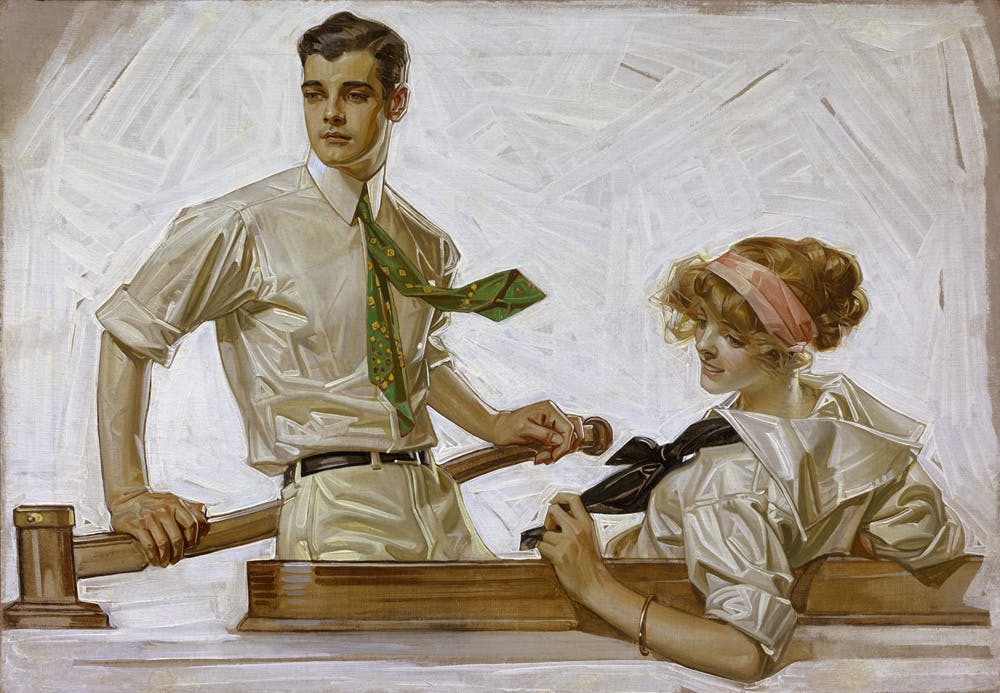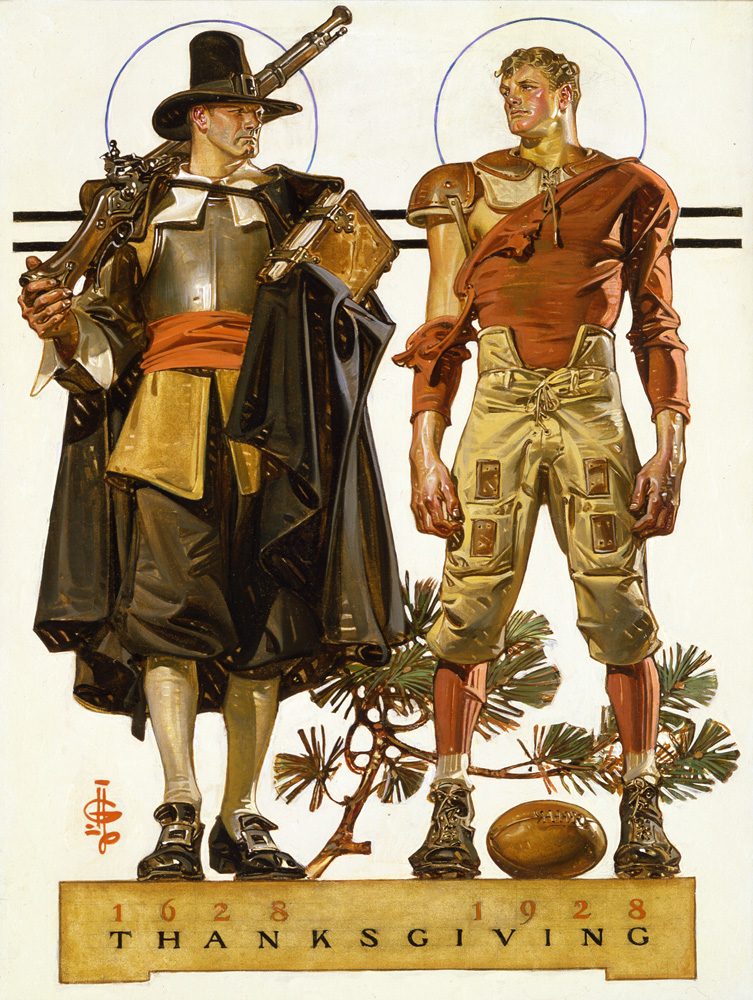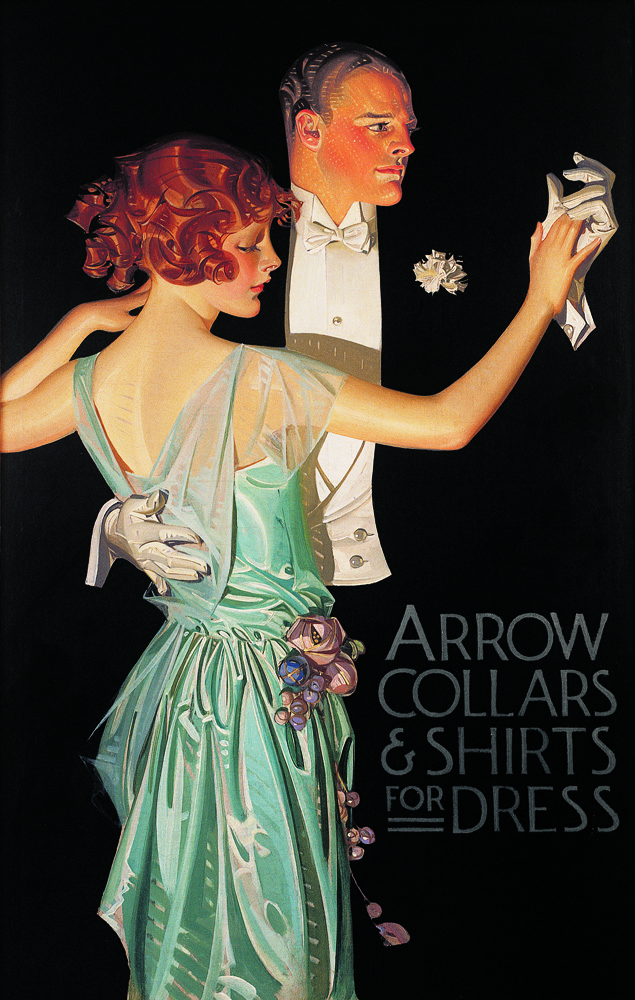Going ‘Under Cover’ To Find Not-So-Hidden Subtext in the Golden-Era Illustrations of J.C. Leyendecker
Yet the work’s intent resists easy categorization. Take, say, the artist’s most famous creation, the iconic Arrow Collar Man, who became so popular among women that the fictional character received its own fan mail.

‘Under Cover: J.C. Leyendecker and American Masculinity‘
The New-York Historical Society
Through August 13
If J.C. Leyendecker isn’t the household name that Norman Rockwell is today, that certainly wasn’t always the case. The Golden Age illustrator, whose heyday spanned the first three decades of the 20th century, preceded Rockwell as the predominant cover artist at the Saturday Evening Post and was his idol, painting 322 covers to the younger artist’s 321.
Leyendecker is the subject of a small, but potent, exhibition at the New-York Historical Society that seeks to find homoerotic content in his ostensibly “All American” images and reclaim the work of a highly influential LGBTQ+ artist into the national narrative.
Although no written accounts confirm his sexuality, the exhibition’s thesis plainly states that Leyendecker was gay, while the use of phrases such as “most likely” and “might have been” in other wall texts give a sense of conjecture.
With today’s eyes, it isn’t hard to find visual evidence to support the show’s argument, from shirtless sailors shoveling coal into a ship’s engine to semi-nude figures that anticipate the later “beefcake” imagery popularized by Bob Mizer’s “Physique Pictorial” magazine. Yet the work’s intent, beyond selling products, ultimately remains unclear, particularly as it comes from a time before camp was codified and male homosocial behavior was prevalent.
Art critic Michael Murphy, in a review of the 2021 documentary “Coded: The Hidden Love of J.C. Leyendecker,” rejects notions that something homoerotic is visible in the work, arguing that such interpretations frame the artist as a “stereotype of the shadowy, devious homosexual covertly insinuating an ‘unnatural’ desire,” and that “this approach is a minimizing, minoritizing, and homophobic form of cultural interpretation.”
The historical society’s exhibition is more nuanced than this, outlining a period of relative comfort and acceptance in New York for the LGBTQ+ community in the 1920s, with examples from the Harlem Renaissance included, followed by a tightening of discrimination, and subsequent closeting, in the 1930s. This parallels the “moral outcry” leading to the Hays Code, adopted in 1930, which restricted, among other things, depictions of homosexuality in Hollywood films.
Rockwell’s “wholesome” images appear to align neatly with post-Code American mores. Yet where his pictures are full of discernible storytelling, Leyendecker’s can be more allegorical and ambiguous. In “Thanksgiving: 1628-1928,” a debonair pilgrim gazes intently at the football-costumed Adonis to his right, who has part of his jersey ripped off, exposing a muscular arm and shoulder pads. Both men look unnaturally tall, and the image has more charge than the simple “then and now” message on its surface.

Like many of today’s paintings made to look good on Instagram, Leyendecker’s work was meant for the camera and mass reproduction, not the connoisseur’s slow gaze. His paintings’ assured brushwork reflect the quickness with which they were executed, but comparisons to the effortless facility of, say, Frans Hals or John Singer Sargent would belie the lack of emotional depth in Leyendecker’s mechanical mark making.
Leyendecker’s odd use of patterned white impasto paint to fill the negative spaces in several pieces reads less like an artistic choice and more like a production consideration. Indeed, the artist’s work was often altered and re-used for multiple purposes and formats, which, according to the curators, “had the effect of fortifying or mitigating the images’ implications of same-sex attraction.”
In contrast with one contemporary artist, Marsden Hartley, who would come to overtly express his same-sex desire in paintings such as “Flaming American (Swim Champ),” from 1940, Leyendecker’s Post cover of a similarly ripped lifeguard makes sure to include adoring women, even if they do look like cartoon cardboard cut-outs.
Similarly resisting easy categorization is the artist’s most famous creation, the iconic Arrow Collar Man, who was often modeled by Leyendecker’s muse, business manager, and life partner, Charles A. Beach, and became so popular among women that the fictional character received its own fan mail.
“Man and woman dancing,” a 1923 painting for an Arrow shirt collar advertisement, features an elegantly dressed woman with geometrically stylized red hair giving side eye to the viewer. The man looks stoically into space, holding the woman with gloved hands as though she were a fragile jewel.
The image is similar in style and palette to “Autoportrait,” by Tamara de Lempicka, a famous 1928 painting made for the cover of a German magazine that has eclipsed its original commercial purpose and become celebrated for its aesthetic merits.
While Leyendecker’s auction record has spiked in recent years, none of the paintings on display here appear poised to accomplish a feat such as Lempicka’s, but they nonetheless form an expertly organized, thought provoking, and important exhibition.


